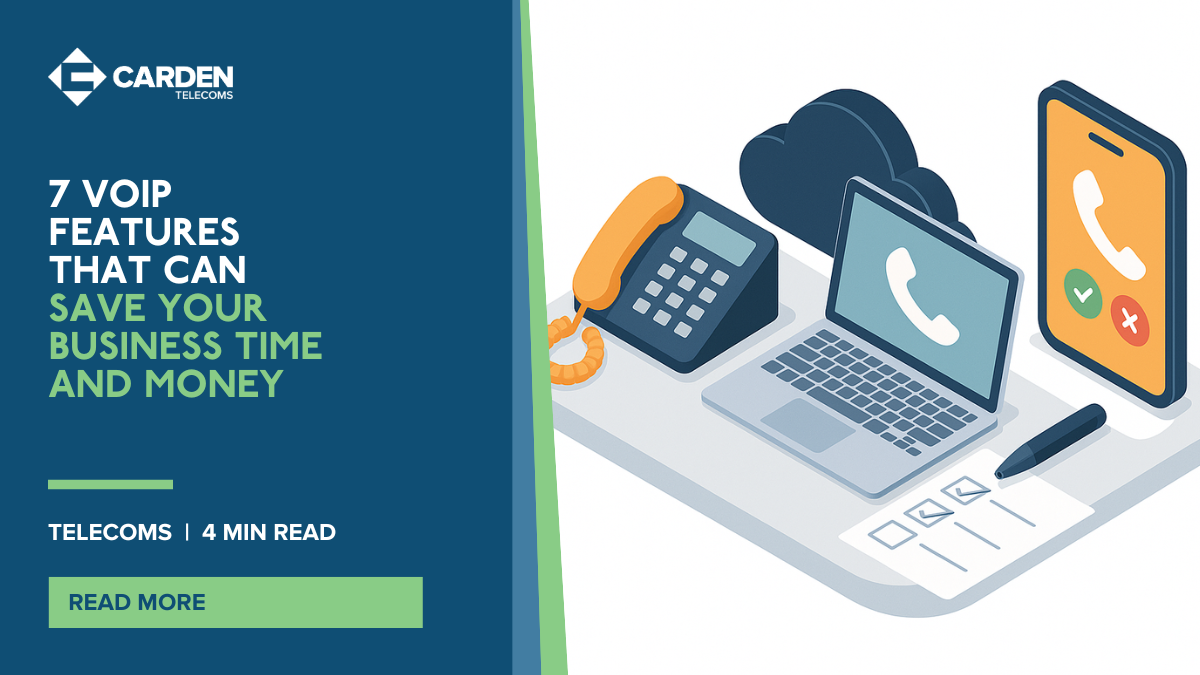Modern VoIP systems are built to do more than just make and receive calls.
In fact, when set up correctly, they can quietly streamline your business, cut out manual processes, and remove the need for extra tech, like second mobiles or extra handsets.
But here’s the thing: many of the best VoIP features go unused simply because businesses don’t know what they’ve got access to, or how to use it.
This article walks through seven powerful VoIP features that don’t just sound impressive, they actually save you time, money, and a fair bit of hassle in the day-to-day running of your business.
1. One Number, All Devices
Your mobile. Your desktop. Your office phone.
With VoIP, they can all ring from the same number, meaning your staff are reachable on whichever device they’re using, no matter where they are.
You don’t need to hand out personal mobiles. You don’t need to issue everyone a separate business phone. And you don’t need to keep track of which number to call someone on when they’re working remotely.
Why it saves you time and money:
- No need for second mobiles or extra SIMs
- Clients always call the same number, less confusion
- Staff can work flexibly without missing important calls
2. Voicemail-to-Email
How many voicemails get ignored simply because they’re trapped on a desk phone somewhere?
With voicemail-to-email, messages are automatically sent to your inbox, either as audio files or written transcriptions. That means you can listen to them anywhere, forward them to a colleague, or even turn them into tickets for follow-up.
Why it saves you time and money:
- No more dialling in to check messages
- Easier to action and assign
- Keeps a written trail, improving accountability
3. Call Forwarding & Routing
Not every call should ring every phone. With VoIP, you can route calls automatically, by time of day, by team, or by availability.
Support calls can go to the helpdesk during office hours, and forward to a duty mobile after 5pm. Sales calls can ring one team first, then another. You control the flow.
Why it saves you time and money:
- No need for receptionists to manually transfer calls
- Clients get to the right person faster
- Reduces dropped calls and voicemails
4. Direct Dial-In Numbers (DDIs)
A DDI gives someone their own direct number without needing a second phone or line. You can assign these to individuals or departments so clients and colleagues can reach them directly.
And yes, even if the staff member is working from home or using a softphone app.
Why it saves you time and money:
- Cuts out internal call transfers
- No need for second devices
- Helps small teams sound like a larger operation
5. Call Analytics & Reporting
You can’t manage what you can’t measure.
Call reporting tools in your VoIP platform show you things like:
- How many calls your team is making or receiving
- Missed calls and response times
- Peak times and average call duration
Perfect for team leaders, support managers, and anyone who wants visibility into performance, or who needs to justify headcount and training.
Why it saves you time and money:
- Optimise staffing around busy times
- Spot gaps in customer service
- Base coaching and planning on real data
6. Click-to-Dial from CRM or Browser
Still dialling phone numbers manually?
With click-to-dial, you can simply click a number in your CRM, email client, or web browser and your VoIP softphone starts the call. It’s small, but it adds up fast, especially for sales teams.
Why it saves you time and money:
- Speeds up outbound calls
- Avoids misdialled numbers
- Links call activity directly to customer records
7. Auto Attendant / IVR (Press 1 for Sales…)
Auto attendants guide callers to the right department or person, without needing a receptionist. They’re professional, easy to update, and help callers get where they need to go quickly.
You can customise greetings by time of day, holiday hours, or even create multi-level menus for larger teams.
Why it saves you time and money:
- Cuts down on manual call handling
- Keeps calls organised
- Helps your business sound professional, even if it’s a small team
Final Thoughts: Smart Features, Real-World Impact
VoIP isn’t just a way to cut down your phone bill, it’s a smarter way to work.
When you start using features like call forwarding, voicemail-to-email, and DDIs, the improvements are real: fewer delays, happier staff, smoother customer experiences, and far less time wasted on manual tasks.
And the best part? Most of these features are already included in modern VoIP platforms, it’s just a case of switching them on and building them into your process.
If you’d like help designing a setup that actually fits your team, we’d love to show you what’s possible.

